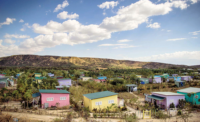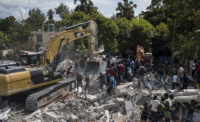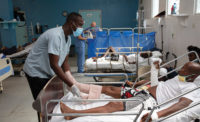Rescue, recovery and damage assessment efforts continue after the magnitude-7.2 earthquake that struck Haiti’s southern peninsula on Aug. 14. An estimated 2,189 people are confirmed dead and 6,000 others were injured in the quake, which had its epicenter some 125 kilometers west of the capital of Port-au-Prince.
Coastal cities of Jeremie and Les Cayes, largely with one- and two-story buildings, are the most affected. The main road connecting the two cities was reported impassible due to landslides and cracked pavement, while broken underground infrastructure lines flooded parts of Les Cayes.
Heavy rains on Aug. 16 from Tropical Depression Grace delayed search and rescue missions. “Our team in Haiti is triaging now, still in rescue mode,” says Jim Ansara, co-founder and managing director of Build Health International. BHI, a nonprofit based in Beverly, Mass., that designs, builds and maintains health care facilities and related infrastructure in underserved regions, including Haiti. Ansara has been building in Haiti since the magnitude-7.2 quake that devastated the nation on Jan. 12, 2010.
BHI has mobilized several of its 100-person local staff to help with damage assessments. COVID-19 is not hampering operations, says Ansara. All team members are vaccinated and masked.
“In recent weeks, we sent many Haitian workers to the [abutting] Dominican Republic to get vaccinated,” he adds.
BHI is doing “down-and-dirty assessments of the buildings to see if they are safe to be in,” says Ansara, adding that the BHI team is leaving the more detailed assessments to seismic engineers from Miyamoto International, whose Port-au-Prince-based engineers arrived in the disaster zone on Aug. 16 to assist with damage assessments, urban search and rescue and recovery strategies.
Haiti's 2010 Quake Killed 200,000+
Miyamoto was involved in the response and recovery efforts after Haiti’s 2010 quake that killed more than 200,000 people, injured hundreds of thousands more, and left over 240,000 buildings damaged or destroyed. In the aftermath, Miyamoto opened an office in Port-au-Prince. The firm has been working with Haiti’s Civil Protection Agency to develop an advanced damage assessment digital app and platform.
According to Miyamoto, since the 2010 temblor, the firm’s engineers have helped train “hundreds of government and private sector engineers throughout Haiti in preparation for swift recovery efforts.” Miyamoto’s Sabine Kast and Kit Miyamoto are expected to arrive in the quake zone this week.
The circumstances and the quake itself are very different from the magnitude-7 temblor, in 2010, which was centered some 12 km west of Port-au-Prince.
Road Infrastructure Is Bad
Haiti has a population of 11.4 million. There are only 1.8 million people in the recent quake's disaster zone. Outside of coastal cities of Les Cayes and Jeremie, “most of the southern peninsula is rural,” says Ansara, “But the road infrastructure is bad,” which makes it harder to get to people, Ansara adds.
The rainy season compounds the situation. And gangs control an area of Port-au-Prince that is the gateway to the southern peninsula, which complicates access, Ansara says. “There is a truce with the government, so some convoys and aid are getting through but most patients are being airlifted to hospitals,” he adds.
Still, though the number of casualties and injured are lower than in 2010, Ansara predicts a massive public health crisis is looming, as a consequence of the jolt to the hospitals.
“The public health infrastructure is largely damaged or destroyed” in a region that is already underserved, he says.
He also predicts economic hardship. “Many of the people affected are subsistence farmers. The quake and the storm that followed ruined crops,” Ansara says.
“We are starting discussions with BHI's local funders and partners about how to bridge the gap in health care over the next few years,” Ansara says.
BHI Buildings Survived
There is some good news about BHI’s more than 15 health care buildings in the affected region, all designed to resist seismic loads since the 2010 quake. They survived the Aug. 14 quake virtually unscathed, says Ansara.
“It is possible to build to a high standard in Haiti, with Haitians,” says Ansara. “You can do this with training, good engineering and good supervision.”
That includes a new solar microgrid system for the public hospital in Pestel. The hospital was badly damaged, says Ansara, but the electrical system stayed working the entire time.
It also includes the Saint Boniface Hospital in Fond-des-Blancs, which is in the affected region.
Earlier this week, BHI sent a plane full of medicine to Haiti. Another plane packed with medical equipment, surgical instruments, tents, shelters and electrical equipment from BHI’s warehouse in New Hampshire, is scheduled to arrive on Aug. 20.
The nonprofit health-care facility operator Partners in Health, one of BHI’s clients, gave BHI $35,000 to redo the electrical system at the Hospital Immaculée Conception, the biggest hospital in Les Cayes, which lost power in the quake. “We have electricians standing by to receive the electrical equipment,” says Ansara. “We hope to be done in four or five days,” he adds.
BHI is raising funds from members of the construction industry to help defray the expenses of the cargo planes and U.S. BHI staff either already in Haiti or on their way. To date, the group has raised nearly $65,000 but has spent “hundreds of thousands,” says Ansara.
BHI has about 100 tradespeople, supervisors and professional staff based in Haiti. Some live in the disaster zone. To date, there have been no casualties in the BHI community, says Ansara, who will not be traveling to Haiti. “I can do more good here,” he says.






Post a comment to this article
Report Abusive Comment